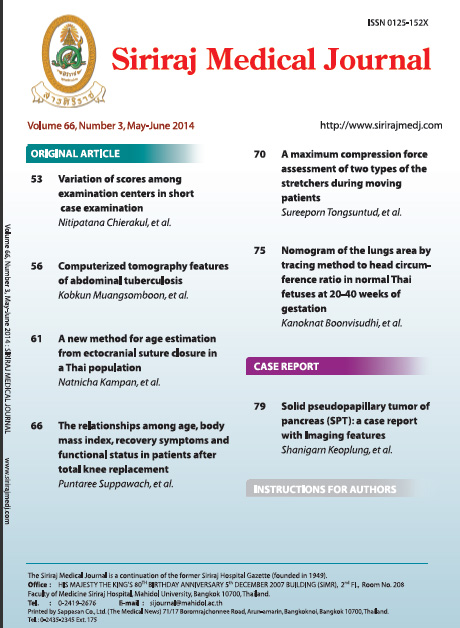The Relationships Among Age, Body Mass Index, Recovery Symptoms and Functional Status in Patients after Total Knee Replacement
Abstract
Background: The recovery period after total knee replacement (TKR) is perceived as one of crisis and associated with recovery symptoms, and adverse physical functioning.
Objective: To study the relationships among age, BMI, recovery symptoms and functional status in Thai TKR patients.
Methods: A cross-sectional correlational design with patients after TKR who were first followed-up at the university hospital were conducted. The data was collected by questionnaires on demographic and clinical characteristics. The recovery symptoms after TKR were measured using the recovery symptoms and their functional status was measured using the Modified Thai WOMAC score. Descriptive statistics and Pearson product moment correlation coefficient were utilized for data analysis
Results: This study included 88 eligible patients, (74 women, 14 men) with an average age of 67.63 years (S.D.=7.9), with an average BMI 27.46 kg/m2 (S.D.=3.91). The most common recovery symptoms were pain (mean=6.41, S.D.=0.95), limping (mean=5.02, S.D.=2.62), and numbness (mean=4.57, S.D.=2.64). The functional status found that most had heavy domestic duties (mean=9.82, S.D.=0.51). Recovery symptoms had a positive relationship with functional status (r=0.395, p<0.01). However, age and BMI were not statistically significant with functional status (r=0.037, 0.033, p>0.05 respectively).
Conclusion: This finding provides a beginning explanation about the phenomena of age, BMI, recovery symptoms and functional status in a specific culture, Thai TKR patients. Interventions to improve functional outcomes in Thailand should be tailored to recovery symptoms management.
Keywords: Total knee replacement, age, body mass index, recovery symptoms, functional status
Siriraj Med J 2014;66:66-69
Downloads
Published
How to Cite
Issue
Section
License
Authors who publish with this journal agree to the following conditions:
Copyright Transfer
In submitting a manuscript, the authors acknowledge that the work will become the copyrighted property of Siriraj Medical Journal upon publication.
License
Articles are licensed under a Creative Commons Attribution-NonCommercial-NoDerivatives 4.0 International License (CC BY-NC-ND 4.0). This license allows for the sharing of the work for non-commercial purposes with proper attribution to the authors and the journal. However, it does not permit modifications or the creation of derivative works.
Sharing and Access
Authors are encouraged to share their article on their personal or institutional websites and through other non-commercial platforms. Doing so can increase readership and citations.










